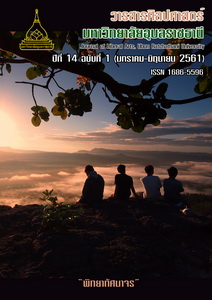การตีความหมายมรดกทางวัฒนธรรมต่อการท่องเที่ยวอย่างยังยืน ตำบลศรีพนมมาศ อำเภอลับแล จังหวัดอุตรดิตถ์ ประเทศไทย
Main Article Content
บทคัดย่อ
เนื้อหาสาระสำคัญของบทความนี้เป็นส่วนหนึ่งของดุษฎีนิพนธ์สาขา
การจัดการมรดกทางสถาปัตยกรรมกับการท่องเที่ยว มหาวิทยาลัยศิลปากร ในหัวข้อ
"การตีความหมายมรดกทางวัฒนธรรมต่อการท่องเที่ยวอย่างยั่งยืน ตำบลศรีพนมมาศ
อำเภอลับแล จังหวัดอุตรดิตถ์ ประเทศไทย" ซึ่งวัตถุประสด์ของดุษฎีนิพนธ์นี้
ประกอบด้วย 1) ตีความหมายของมรดกทางวัฒนธรรมสำหรับกลุ่มผู้มีส่วนได้เสียเฉพาะ
กลุ่มและ 2) สร้างแผนการท่องเที่ยวอย่างยั่งยืนซึ่งจะเป็นประโยชน์ต่อนักท่องเที่ยว
ชุมชนและรัฐบาลท้องถิ่น รวมถึงการจัดเตรียมกรอบความคิดสำหรับนักวิจัยที่ต้องการ
ศึกษาการมีส่วนร่วมของชุมชนในบริบทที่คล้ายคลึงกัน พื้นที่วิจัยในตำบลศรีพนมมาศมี
ทรัพยากรมรดกทางวัฒนธรรมมากมาย อุตสาหกรรมการท่องเที่ยวในท้องถิ่นส่วนใหญ่
ของตำบลนี้ไม่ได้ใช้ประโยชน์จากสินทรัพย์เหล่านี้และไมให้ความสำคัญกับการจัดลำดับ
ทรัพยากรมรดกที่มีดที่สุดในด้านการพัฒนาการท่องเที่ยวอย่างยั่งยืนและการท่องเที่ยว
โดยทั่วไป ดังนั้นการวิจัยครั้งนี้จึงคันหาการตีความหมายคุณค่าของมรดและสร้างแผน
เพื่อพัฒนาการท่องเที่ยวอย่างยั่งยืน
Downloads
Article Details
เอกสารอ้างอิง
Continuum.
ASTV manageronline. (2015, October 5). Biking, Relaxing, Site Seeing and
Listening to Legendary of Laplae: the Widow Town "They said
don't tell lie in this town!Retrieved from:
http://www.manager.co.th/Travel/ViewNews.aspx?NewsID=95800001
11773
Brehony, E. (1989). Projects of the People or for the People: A Study of
Villagers Participation in Three Selected Projects in Two Villages
in Tanzania. 'Unpublished Masters in Rural Development thesis).
University College Dublin, Department of Agribusiness, Extension
and Rural Development.
Brodie, E., Cowling, E., & Nissen, N. (2009). Understanding Participation: A
LiteratureReview. London: National Council for Voluntary
Organisations.
Carey, G, Crammond, B., & Riley, T. (2015). Top-Down Approaches to
Joined-Up Government: Examining the Unintended Consequences
of Weak Implementation. International Journal of Public
Administration, 38, 167-178.
Cohan, J. M., & Uphoff N. T. (1980). Participation's Place in Rural
Development: Seeking Clarity through Specificity. World
Development, 8(3), 213-235.
Commission of the European Communities.(2001). European
Governance:A White Paper. Brussels: Commission of the
European Communities.
Cultural Office of Uttaladit. (2015). Knowledge of Local Wisdom Mueang
Laplae. Uttaladit: P. of Set Art (Por Karn Pim).
Green, M. C., & Brock, T. C. (2005). Organizational membership versus
informal interaction: contributions to skills and perceptions that
build social capital. Political Psychology, 26(1), 1-25.
Ham, S. H. (1992). Environmental Interpretation: A practical guide from
people with big ideas and small budgets. Golden, Colorado:
North America Press.
Hammitt, W. E. (1984). A theoretical foundation for Tilden's interpretative
principles. Journal of Environmental Education, 12, 13-16.
Hardy, D. (1988). Historical geography and heritage studies. Area, 20(4), 333-
Macdonald, L. (1995). NGOs and the problematic discourse of participation:
Cases from Costa Rica. In D. B. Moore, & G. J. Schmitz's (Eds.),
Debating development discourse: Institutional and popular
perspectives (pp. 201-229). New York: St. Martin' Press, Inc.
Minister of Tourism and Sports. (2017). The Second Thailand National
Tourism Development Plan (2017-2021). Bangkok: n.p.
Royal Thai Government. (2017). Thailand's 20-Year National Strategy
(2017-2036). Bangkok: n.p.
Minister of Tourism and Sports. (2017, February 16). The number of visitors
and tourists from January to December 2017. Retrieved from:
http://wwww.mots.go.th/ewt_dl_link.php?nid=8367
National Economic and Soxcial Development Board. (2017). The Twelfth
National Economic and Social Development Plan (2017-2021).
Bangkok: n.p.
Oakley, P. (1987) Sate or Process, Means or End? The Concept of
Participation in Rural Development. Reading Rural Development
Communications. Bulletin 21, Berkshire: Reading University.
Petric, L. (2007). Empowerment of communities for sustainable tourism
development: Case of Croatia. Turizam: medunarodniznanstveno
-strucni casopis, 55(4), 431-443.
Porritt, J. (2007). Capitalism: As if the world matters. 2nd ed. London:
Earthscan.
Mongsawad, P. (2010). "The Philosophy of Sufficiency Economy: a
contribution to the theory of development." Asia-Pacific
Development Journal, United Nations Economic and Social
Commission for Asia and the Pacific (ESCAP), 17(1), 123-143.
Rappaport, J. (1984). Studies in Empowerment: Introduction to the Issues.
Prevention in Human Services, 3, 1-7.
Regnier, K, Gross, M, & Zimmerman, R. (1994). The Interpreter's
Guidebook: Techniques for programs and presentations. 3" ed.
Stevens Point: University of Wisconsin.
Risk, P. (1994). People -based interpretation. In R. Harrison (Ed.), Manual of
Heritage Management(pp.320-330. Oxford: Butterworth
Heinemann.
Sharpe, G. W. (1982). Selecting the interpretative media. In G. W. Sharpe
(Ed.), Interpreting the Environment (pp. 3-26). New York: Wiley.
Si Phanom Mat Sub Province. (n.d). Way of Life Tourism in Laplae
[leaflet]. Uttaladit: n.p.
Swarbrooke, J. (2005). Sustainable Tourism Management. Oxon: CABI
Publishing.
Tourism Authority of Thailand. (2010, February). Retrieved from:
http://www.thailandtourismus.defileadmin/downloads/12/Sukhothai
pdf The Thailand Community Based
Theerapappisit, P. (2003). "River Life Transition: From Agro-cities to
Agritourism'. In R. King, O. Panin, & C. Parin (Eds), Modernity,
Tradition, Culture, Water, Conference Proceedings: Bangkok-
Melbourne-Bordeaux Symposium, Bangkok, October 2002, Bangkok:
Kasetsart University Press.
Theerapappisit, P. (2012). The bottom-up approach of community-based
ethnic tourism: a case study in Chiang Rai. In M. Kasimoglu, & H.
Aydin (Eds.), Strategies for Tourism Industry: Micro and Macro
Perspectives (pp. 267-294). doi: 10.5772/37137
The World Tourism Organization. (2011). Capacity Building Program, Asia
Workshop Il. Retrieved from:
http:/statistics.unwto.org/sites/allfiles/pdf/unwto_tsa_1.pdf
Tilden, F. (1997). Interpreting Our Heritage. Chapel Hill: University of
North Carolina Press.
Timothy, D. J., & Boyd, S. W. (2003). Heritage Tourism. Harlow. Pearson
Education Limited.
Tourism Authority of Thailand, Offce at Phrae Province. (2015). Tour Guide
to Uttaladit. Phrae: n.p.
Tourism Institute (n.d.). Concept CBT. Retrieved from:
http:/cbtnetwork.org/th/?page_id=47
United Nations Development Programme.(1997). Governance for
sustainable human development. New York: Oxford University
Press Inc.
United Nations Environment Programme and World Tourism Organization.
(2005). Making Tourism More Sustainable: A Guide for Policy
Makers. Paris & Madrid: n.p.
Uttaladit Office. (n.d.). Lablae District Retrieved from:
http://ww.uttaradit.go.th/utteng/ web/lablae1.php
Wibulswasdi, C., Piboolsravut, P,, & Pootrakool, K (2012). Sufficiency
economy philosophy and development. Bangkok: The Crown
Property Bureau.


